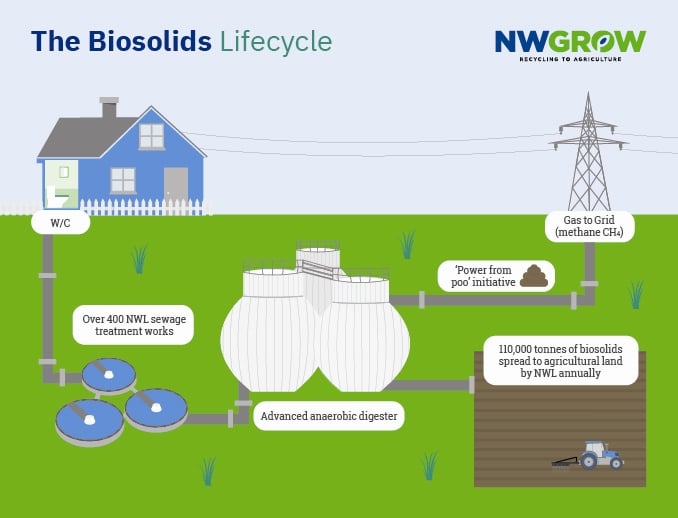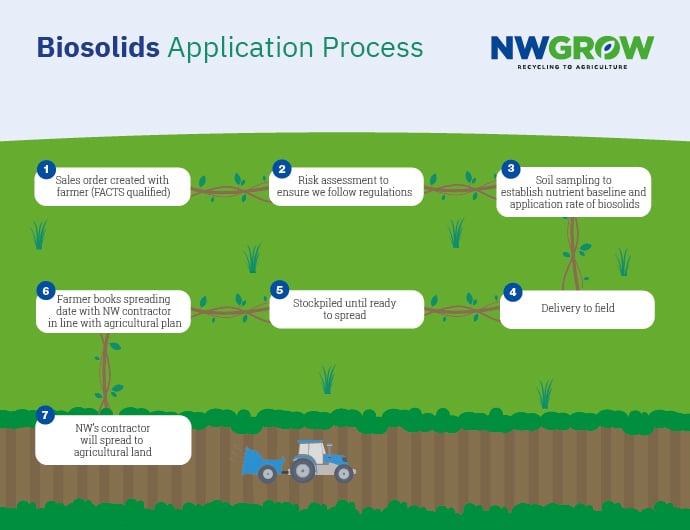
What is NWGROW?
NWGROW puts recycling and agriculture together for a sustainable future.
How does it all work?
With the science of sewage. Bioresources, to be more precise.
We have over 400 sewage treatment works in the north east of England.
Those treatment works clean both industrial and domestic wastewater, and the cleaned water is returned to the environment.
But clean water isn't the only product of our sewage treatment processes.
Sewage sludge is the delightful term for material that contains many nutrients. We've realised we can take this sludge and transform it into environmentally-friendly fertiliser. We call this "biosolids".
Information about biosolids
This organic material contains a great mix of nutrients for farming and agriculture, including:
- nitrogen
- phosphorous
- potassium, and
- trace elements
The amounts of nutrients in the biosolids, and their sustainability for crop types and rotation, is decided by the processes used at the sewage treatment works.
The European Union (EU) and the UK Government usually recognises biosolids as the best practical option for our environment.
We supply biosolids to suitable locations after carrying out environmental risk assessments.
Biosolids can be used on grassland or arable land after a harvest.
Before biosolids are used at a new location, soil samples are taken, analysed and checked against risk assessments.
Good agricultural practice requires that users of biosolids must take into account the nitrogen and phosphate content of both the soil and biosolids, as well as the nutrient requirements of the crop.
Yes. The Department for Environment, Food and Rural Affairs (DEFRA) regulate biosolids.
All biosolids used on agricultural land are applied in accordance with The Sludge (Use in Agriculture) Regulations and The Code of Practice for the Agricultural Use of Sewage Sludge.
Northumbrian Water and their partner, Veolia Organics Recycling, follow RB209 Nutrient Management Guide (9th Edition) best practices.
Biosolids have been researched for sustainable agricultural use for over 45 years. This was to make sure biosolids could be used safely and without harming the environment.
The work confirms that any risk to the food chain or the environment from recycling biosolids to land is extremely small provided that it is carried out in accordance with the regulations above.
The Safe Sludge Matrix (ADAS. 2001) represents an agreement made between the water industry and British Retail Consortium (BRC). It provides guidance on crop types that can be grown following biosolids application and harvest intervals to make sure there are no risks to food safety.
Water UK and the European Commission confirm that there has never been a recorded outbreak of human ill health or crop contamination as a result of recycling biosolids to land.
The water industry developed a Biosolids Assurance Scheme (BAS) with Water UK, introduced in autumn 2013.
It brings legislative and code of practice controls on biosolids recycling to agricultural land into one independently audited standard, to ‘openly demonstrate that biosolids are recycled to agricultural land in accordance with legislation and best practices using safe and sustainable processes that are in the best interests of the public and the environment‘.
When our sewage works clean the water to put back into the environment, the organic material that is produced is, quite literally, waste.
But why should we waste it?
Fertiliser, compost, manure. It's all 'waste', but it's waste with purpose.
Biosolids are so nutrient-dense that they stabilise and improve the soil used in agriculture. It helps root development, and makes the crops more resilient.
Earthworms are encouraged by the nutrition in biosolids, and they help lock carbon into the soil.
Plants feed off the biosolids, too. In addition to nitrogen and phosphorous, they'll use the sulphur, magnesium, potassium and other elements to thrive. These elements aren't found in manufactured fertilisers.
Biosolids are good for the crops, the soil, the environment, and we're reducing wasted waste.
The lifecycle of biosolids

Further information
Anaerobic digestion is the process where microorganisms break down biodegradable material (in this case sewage sludge), because they don't have oxygen.
By controlling the process, two useful products are obtained: biogas and residual digestate (a nutrient-rich fertiliser).
Biogas, which contains a mix of methane and carbon dioxide, can be used to produce electricity and heat, or it is purified for injection into the gas network.
Advanced Anaerobic Digestion (AAD) processes have been developed to add even greater performance to the digestion process, as well as reducing the overall mass of solids.
For sewage sludge, conventional anaerobic digestion will destroy 30 to 40% of the organics present, whereas advanced anaerobic digestion may achieve 60% or more.
Biogas consists of methane, carbon dioxide, and traces of other ‘contaminant’ gases.
The methane part of the gas is cleaned to remove impurities and propane is then added so that it matches the consistency of the public gas network.
The gas can then be injected into the gas distribution network.
We're the first water company in the country to use all of our sewage sludge to produce gas and electricity.
Bioresources have transformed sewage sludge from being a waste product that needed a lot of energy to clean up, into a fuel being used to produce green energy instead.
Biosolids application process

Power from poo
Watch video (opens new window)Useful contacts
Please contact:
For sales:
- Newcastle, Gateshead, Northumberland – Steve Kendall 07749948380
- Co Durham, Darlington, Stockton and North Yorkshire - Kristen Butters 07710779872
For advice or any other enquiries:
- Georgia Swinhoe – 07395848607
- Bryan Craggs – 07972192208
Please call our Customer Centre on 0345 717 1100.
Please see below other contacts:
- Biosolids Assurance Scheme at www.assuredbiosolids.co.uk
- Water UK on 0207 344 1844, or visit www.water.org.uk
- DEFRA, on 0845 933 5517, or visit www.defra.gov.uk
- National Farmers' Union, on 0247 685 8500 or visit www.nfuonline.com
- ADAS, on 0845 766 0085, or visit www.adas.org.uk
- Environment Agency, on 03708 506 506, or visit
Are you sure?
Changes are waiting to be saved